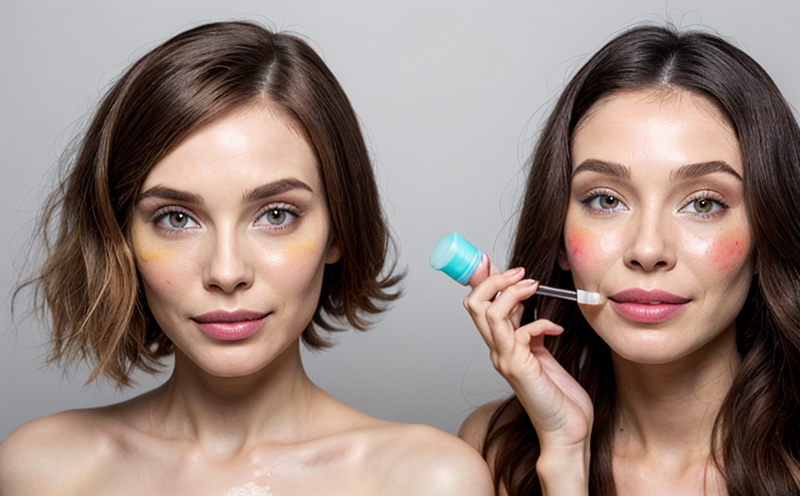Color Stability Testing in Natural Pigment Cosmetics
In the realm of natural and organic cosmetics, color stability testing is a critical process. The integrity and longevity of cosmetic products are heavily influenced by their ability to maintain consistent color over time under various environmental conditions. This is especially important for natural pigments, which can be sensitive to temperature, humidity, light exposure, and other factors that may cause them to degrade.
Natural pigments derived from plants, minerals, or animals have gained popularity due to consumers' increasing preference for eco-friendly products free of synthetic chemicals. However, these pigments are not as stable as their synthetic counterparts and can vary in quality depending on the source and processing method used by manufacturers. As a result, rigorous color stability testing is essential.
During color stability tests, samples are exposed to controlled conditions that mimic real-world scenarios such as high temperatures, UV light exposure, or humidity levels found in different climates. By doing so, laboratories can predict how long natural pigments will maintain their intended colors and assess the overall quality of cosmetic products containing these ingredients.
The importance of this testing cannot be overstated for several reasons:
- Consumer trust: Ensures that consumers receive high-quality products that meet expectations regarding color.
- Regulatory compliance: Adheres to international standards such as ISO, ASTM, and EN.
- Sustainability: Helps manufacturers choose the most stable natural pigments available, reducing waste from product recalls or returns due to unsatisfactory performance.
By conducting thorough color stability tests early in the development process, companies can make informed decisions about ingredient sourcing, formulation adjustments, and packaging materials that will extend shelf life while maintaining aesthetic appeal.
| Environmental Factor | Description |
|---|---|
| Temperature | Test samples at various temperatures ranging from -20°C to +60°C to simulate storage conditions in different climates. |
| Humidity | Expose samples to humidity levels between 25% and 95%, depending on the intended use of the product, to evaluate stability under various environmental conditions. |
| Light Exposure | Simulate natural sunlight exposure using UV lamps with different wavelength ranges (e.g., UVA, UVB) to determine how much light will impact color retention over time. |
Understanding these factors allows laboratories like ours to provide accurate and reliable results that help ensure consistent product quality throughout its lifecycle. Our state-of-the-art facilities employ advanced equipment designed specifically for this type of testing, ensuring precise measurement and repeatable outcomes.
To summarize, color stability testing plays a pivotal role in the development, manufacturing, and quality assurance processes within the natural and organic cosmetic industry. It ensures that products not only meet regulatory requirements but also deliver on their promise to consumers by maintaining vibrant colors even after extended periods of use or exposure to harsh environmental conditions.
Why It Matters
The importance of color stability testing in natural pigment cosmetics cannot be overstated. Consumers expect products to look and perform as advertised, especially when they are paying more for eco-friendly options compared to synthetically produced ones. Ensuring that these products maintain their intended colors over time enhances consumer satisfaction and loyalty.
Regulatory bodies worldwide have strict guidelines regarding the labeling of natural ingredients in cosmetics. For instance, according to regulations specified by the European Union (EU), all cosmetic products must include detailed information about the composition including any botanical or mineral sources used for pigmentation purposes. Failure to comply with these requirements can result in fines and damage to brand reputation.
Moreover, from an environmental perspective, using natural pigments responsibly means minimizing waste associated with discarded goods because of poor color retention. By investing in robust quality control measures like color stability testing early on, manufacturers reduce unnecessary production costs while promoting sustainable practices.
Scope and Methodology
The scope of our color stability testing services encompasses a wide range of natural pigments commonly utilized in cosmetic formulations. These include but are not limited to:
- Carotenoids
- Anthocyanins
- Ethoxyquin
- Beta-carotene
We use a combination of laboratory techniques and analytical instrumentation to assess the stability of these pigments under different environmental conditions. Our approach typically involves:
- Sample preparation: Properly preparing samples according to industry standards ensures accurate measurements.
- Environmental exposure: Exposing samples to controlled temperatures, humidity levels, and light exposures simulates real-world usage scenarios.
- Data collection & analysis: Utilizing high-resolution spectrophotometers capable of detecting minute changes in color intensity allows us to generate reliable data points for comparison purposes.
Once the testing phase is complete, we produce comprehensive reports detailing observed variations in color over time. These documents serve as valuable resources both during product development stages and post-market analysis activities such as shelf-life extension studies or batch-to-batch consistency checks.
Industry Applications
Color stability testing is applicable across numerous sectors within the natural and organic cosmetic industry, including but not limited to:
- Skin care products (creams, lotions)
- Hair care products (shampoos, conditioners)
- Makeup items (foundation, lipstick)
- Body care products (bath oils, soaps)
Here are some specific examples where this testing plays a crucial role:
| Pigment Type | Product Example | Stability Issue Addressed |
|---|---|---|
| Carmine (derived from cochineal insects) | Lipsticks | Variations in color intensity due to pH levels or light exposure. |
| Paprika extract | Eye shadows | Loss of color brightness caused by prolonged storage at elevated temperatures. |
| Beta-carotene (derived from carrots) | Facial moisturizers | Decrease in carotenoid content leading to reduced antioxidant activity over time. |
By addressing these issues proactively through rigorous testing protocols, manufacturers can enhance the overall quality and reliability of their products while fostering customer confidence and satisfaction. This ultimately contributes to a more sustainable business model aligned with consumer values around health and wellness.





